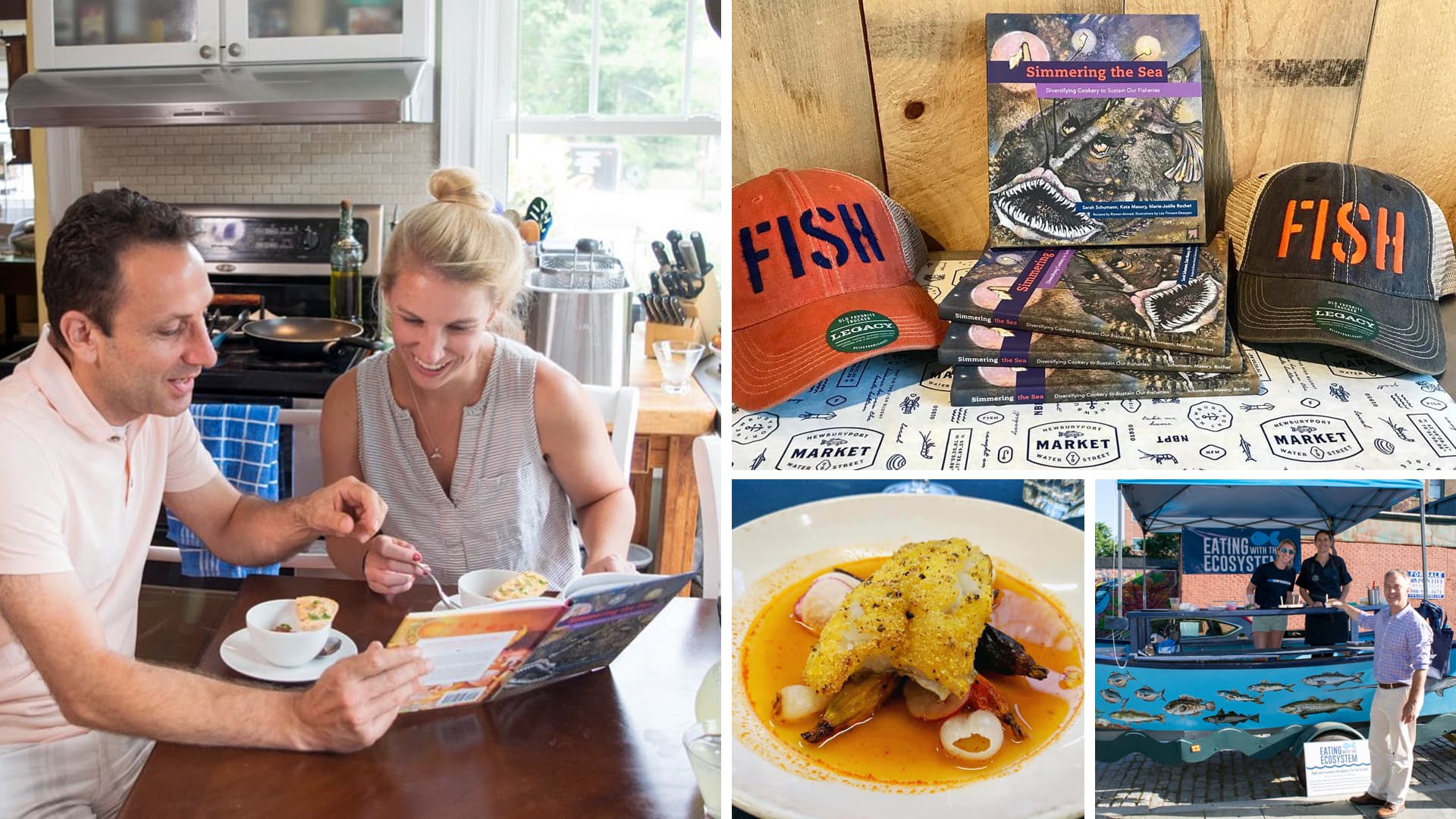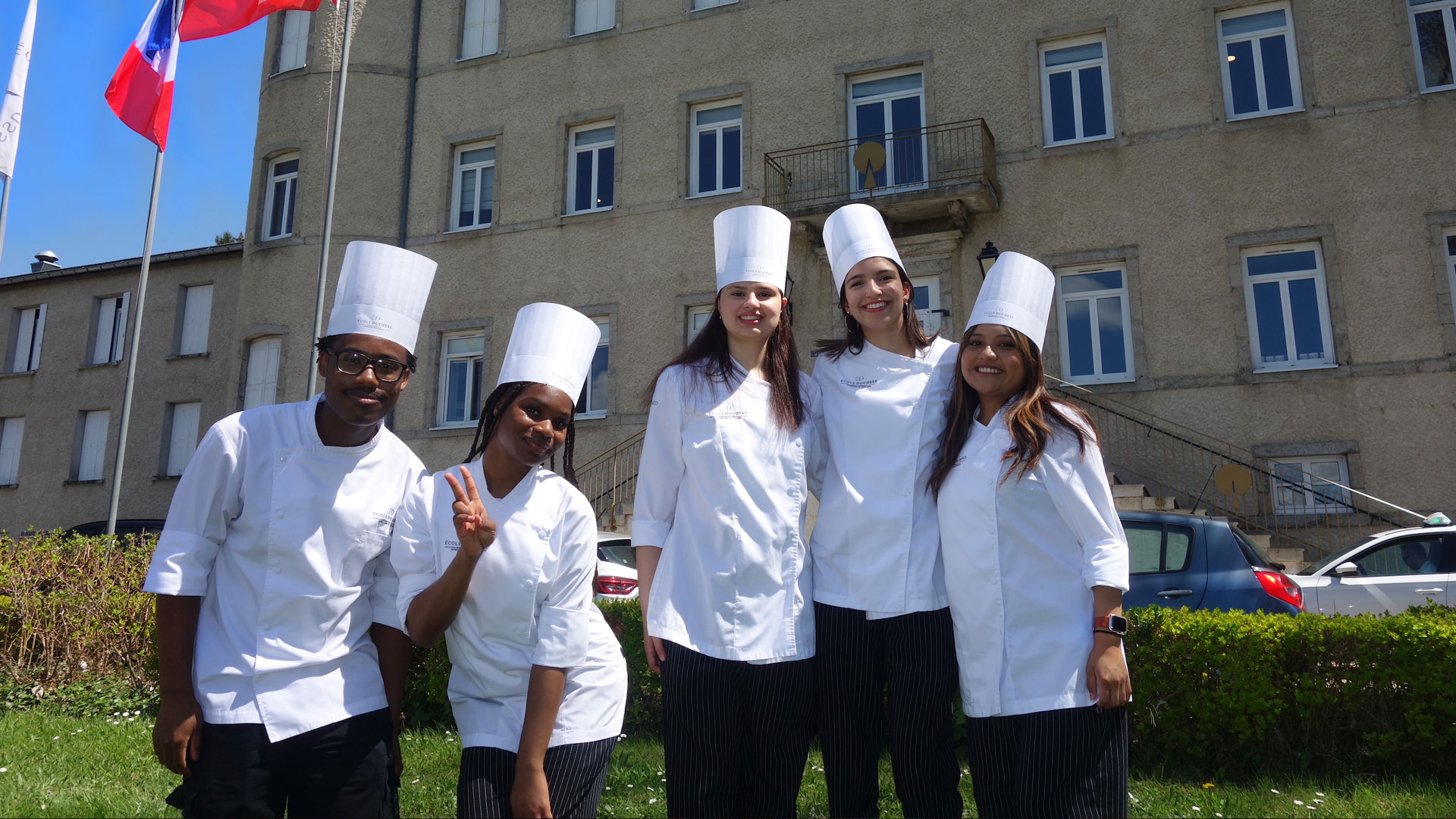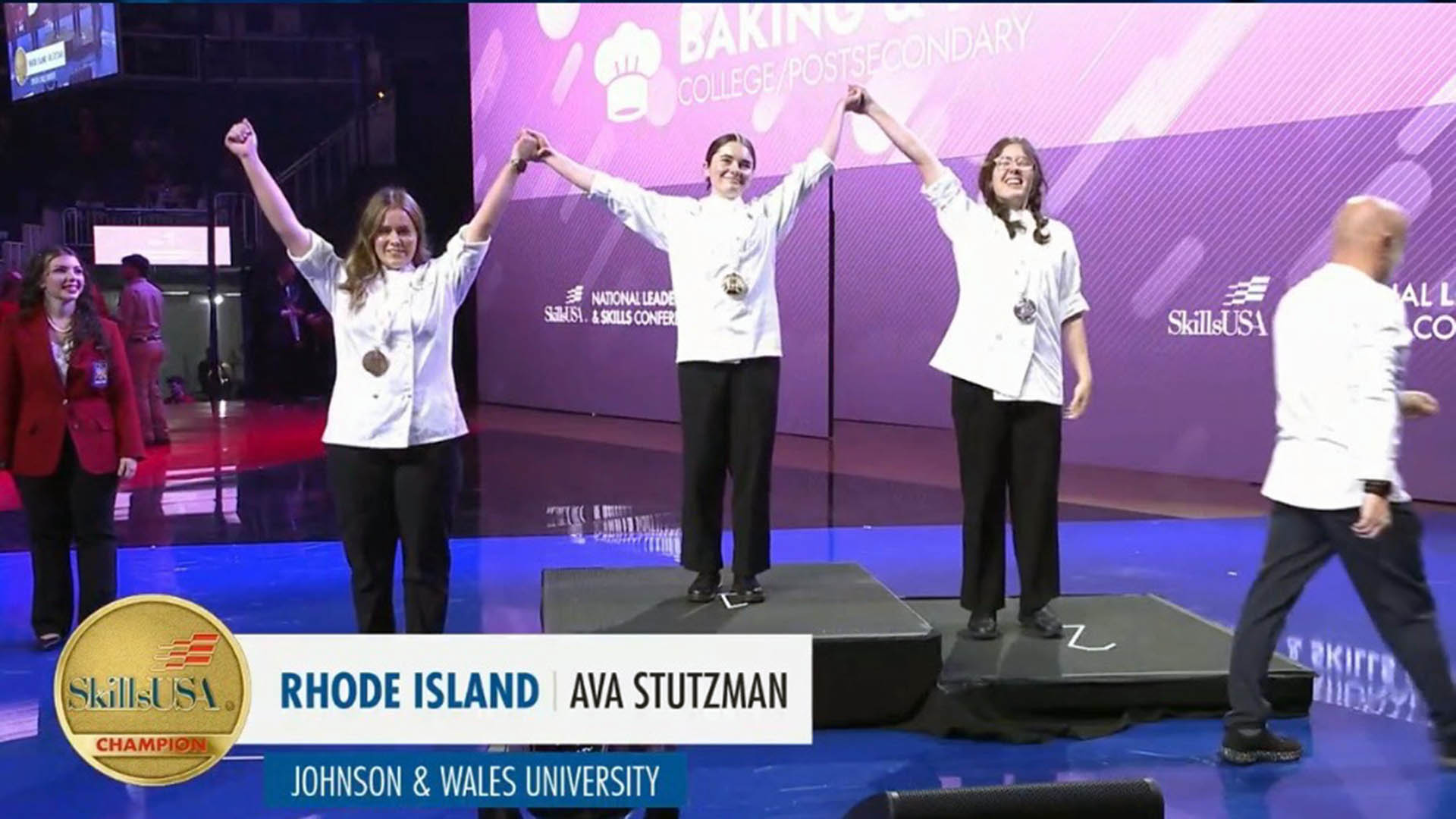Can We Eat Our Way to Healthier Oceans? Yes, According to New Cookbook ‘Simmering the Sea’
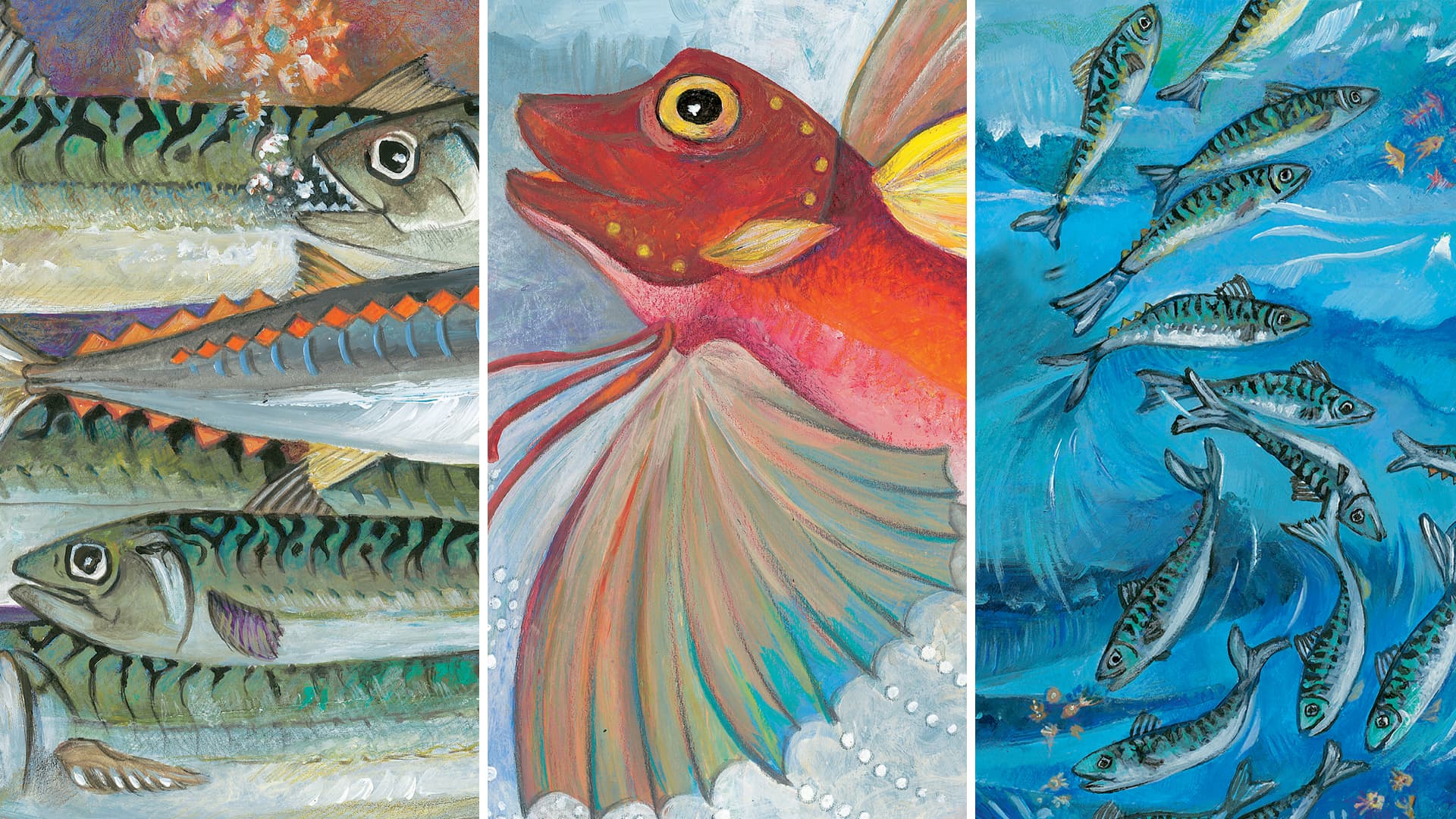
“Simmering the Sea: Diversifying Cookery to Sustain Our Fisheries” offers a fresh perspective on the traditional New England seafood cookbook. A collaboration between the University of Rhode Island, RI-based nonprofit Eating with the Ecosystem, and JWU Providence’s College of Food Innovation & Technology, the book takes readers on an underwater journey illustrating the incredible diversity of seafood that swim in our local waters.
Each section of the book highlights a different segment of the ecosystem, from “sunlight catchers” like kelp through to “fish hunters” (bluefish, skate) and “bipedal predators” (that’s us).
The recipes, which were developed by JWU Chef Rizwan Ahmed with assistance from students, showcase these underutilized but often plentiful species in easy-to-follow recipes that have built-in flexibility depending on what’s available at your local market.
Keeping our ecosystem in balance is crucial for the survival of our many cornerstone species. “Simmering the Sea” seeks to address this by encouraging readers to eat across the food chain and try seafood they’ve never eaten before.
Eating with the Ecosystem Program Director Kate Masury and Chef Ahmed share the inspiration for the cookbook, as well as how it came together. Oh, and an exclusive recipe for Acadian redfish, a once-depleted cold water-dwelling fish that is found in gulf waters along the coast of Maine.
What sparked the idea of the cookbook?
Kate: Eating with the Ecosystem has been wanting to put together a cookbook for a while now. We consistently heard from attendees at our events that they would enjoy a cookbook featuring recipes for many of the New England species we often teach about.
The concept came from our research partner, Jeremy Collie, a fisheries scientist at URI. He was inspired by a French cookbook called “ Mitonnez la mer, Recettes variées pour une pêche durable” (“Simmering the sea: Diverse recipes for sustainable fisheries”) by French scientists Marie-Joelle Rochet, Verena Trenkel, and Pascal Lorance (from the French Research Institute for Exploration of the Sea).
"This is more than a kitchen manual — it’s also a culinary travel guide to marine ecosystems."
When Jeremy approached Eating with the Ecosystem with the idea, we were delighted by the opportunity to be involved — we loved the concept behind “ Mitonnez la mer,” and it was a perfect fit with our mission.
How does “Simmering with the Sea” support Eating with the Ecosystem’s mission?
Kate: A place-based approach to sustaining New England’s wild seafood is all about eating in balance with our marine ecosystem while supporting the habitats that produce our seafood and the fishing communities that catch it.
The book not only provides recipes for many of the overlooked local seafood species, but also educates readers about
- the habitats these species use
- their role in the ecosystem
- how they are caught
We hope that “Simmering the Sea” will inspire local eaters to branch out and enjoy a diversity of local seafood species, creating demand in the marketplace, balance in our marine food webs, and support our local fishing communities.
I love the idea of “eating like a fish” — choosing what’s local and in-season as well as eating from across the food chain. How does the final lineup of recipes reflect this diversity?
Kate: There are hundreds of locally landed seafood species that can be found in New England waters — we couldn’t include all of them in this cookbook.
When choosing species to feature, we divided them by their “trophic guild” — that is, what they eat and their role in the ecosystem — and chose a representative variety of species from each category.
We also tried to select species that are abundant and local but often overlooked by consumers. (The idea being that readers could start incorporating these delicious species into their diets.)
That said, the starring fish (or shellfish) in each of the recipes can easily be substituted for another fish with similar culinary properties. For example, the steamed periwinkles recipe can be prepared with littlenecks, steamer clams, whelks, mussels and lobster.
At what point did JWU get involved? Did you bring the idea of the cookbook to the deans first, or was there another process?
Kate: JWU became involved in the project through our relationship with Chef Rizwan Ahmed. Chef Riz has been a longtime friend of Eating with the Ecosystem since his days as chef-proprietor of the Hourglass Brasserie in Bristol, RI.
Sarah Schumann, one of the book’s authors and one of the founding board members of Eating with the Ecosystem, was at the time working at a local seafood stand. She had a sign posted that she was looking for chefs for an Eating with the Ecosystem dinner series.
They got to talking and Sarah learned that Chef Riz was not only a talented chef but also had a multifaceted appreciation for marine life gained through an early career as a marine biologist. He was a natural fit and our first Eating with the Ecosystem dinner was hosted at the Hourglass. (We still remember with awe the dish Riz created with skate cartilage chips dyed with squid ink.)
Chef Riz: I remember first meeting Sarah at Mount Hope Farmers Market in Bristol where I used to go on Saturdays to buy my ingredients for the restaurant.
Having just opened my restaurant and already showcasing a menu of underutilized seafood, I was drawn to her philosophy and held the first of many Eating with the Ecosystem dinners. Eventually other restaurants joined in.
When Sarah approached me to help with the cookbook and I heard that URI was also involved, I thought that JWU should join the mix. It is important to understand that the more institutions and environmental organizations involved in the awareness of diversifying our seafood palate, the greater the impact we can have on our community.
"We hope that ‘Simmering the Sea’ will inspire local eaters to branch out."
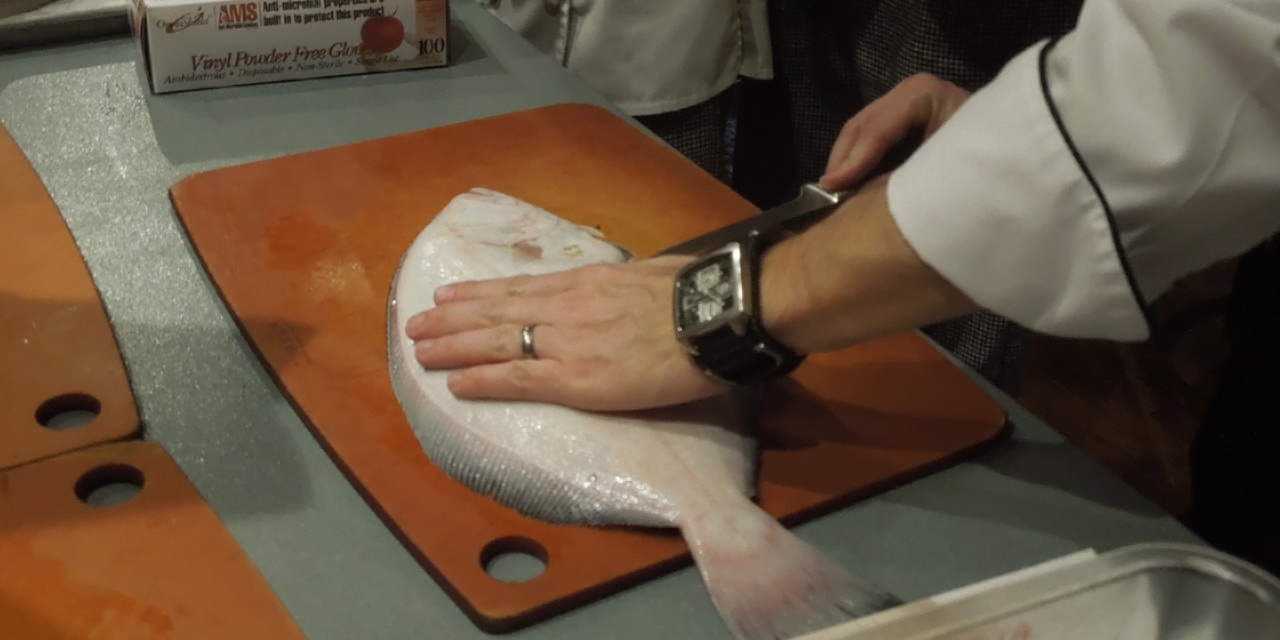
Tell me how you and your students approached creating these recipes so they would be easy and fun to make at home.
Chef Riz: The challenge was not coming up with the recipes but trying to make them more acceptable to the average home cook. Two criteria had to be met: Is it delicious and is it approachable?
All the recipes in the cookbook “Simmering the Sea” had been used and tested in one form or another at my modern French restaurant the Hourglass Brasserie, which I ran for 5 years before joining JWU. I decided to revisit those recipes and mold them with simple ingredients that could be enjoyed just as much. Some recipes are French classics like en papillote, escabeche and skate with capers and butter. These recipes have been around for decades — and rightfully so.
Once I compiled the recipes for the species that were selected by Sarah, Kate and Jeremy, we went to work. JWU ordered all the necessary ingredients needed and I selected a group of students who shared in our vision. It took about 3 days of tweaking and readjusting the recipes until we were confident the recipes tasted delicious and were approachable.
You’ve been road-testing the cookbook at various events and farmers markets. What’s the feedback been like so far?
Kate: The feedback has been extremely positive. At first people tend to look at us like we are crazy when we tell them we’re serving species like sea robin, Acadian redfish, or scup, because they have either never heard of them before or were not aware you could eat them. But once they try them, their faces light up and they normally exclaim something like, “Wow, this is actually really good!” as they reach for another sample.
What’s the next project on the horizon?
Kate: We are always working on multiple projects. “Simmering the Sea” is part of a research project in partnership with Jeremy Collie and Hiro Uchida at URI, the goal of which is to begin to answer the question, “How well does the composition of species in our regional New England seafood marketplace match the composition of species in our local ecosystems — and what would make these two things match better?”
The project’s next phase involves conducting key informant interviews with members of our seafood supply chains to figure out how to get a more representative array of local seafood available in our New England seafood marketplace.
We have multiple other projects on the agenda:
- working with fishermen and consumers on real-time seafood marketing for local underutilized species
- utilizing seafood retail markets as places to educate and engage consumers in seafood habitat conservation
- partnering with local chefs to hold seafood cooking demos and classes at our events like our Scales & Tales Food Boat events or School of Fish classes
We currently do not have a plan for another cookbook at the moment — but you never know!
RECIPE: ACADIAN REDFISH ESCABECHE
Our bright red color is eye-catching—and a bit outlandish for drab New England where we live. We are a long-living, slow-growing species, with a lifespan into our fifties if given the chance. We are careful parents.
We are lovers of the cold. When other fish start heading inshore for summer sunshine (or more probably, for the feast this sunlight produces), we dive deep into pockets of cold water. We thrive from Newfoundland to Georges Bank, and once we’ve found a good spot, we don’t move around too much.
Serves 4.
FISH
- 4 Acadian redfish fillets, skin on
- 2 tablespoons olive oil
- Salt to taste
SAUCE
- 2 tablespoons olive oil
- ½ carrot, peeled and cut thinly in coins
- 1 shallot, thinly sliced
- 2 garlic cloves, crushed
- 1 lemon, thinly sliced
- 1 teaspoon whole white pepper, crushed
- 1 teaspoon whole coriander, crushed
- 4 sprigs thyme
- 2 bay leaves
- Pinch of cayenne pepper
- ½ cup white wine vinegar
- 2 cups water
1. Make several slits on skin side of fish. Set pan over medium heat and add oil. Season fish with salt and sear lightly, skin side down, until cooked halfway, about 1-2 minutes. Remove and place fish in serving bowl, skin side up. Use same pan to make marinade.
2. In the same pan that was used to cook the fish, add oil and place over medium heat. Add carrots, shallots, and garlic and sweat for 2-3 minutes.
3. Add lemons, pepper, coriander, thyme, bay leaves, and cayenne. Cook for another 2-3 minutes.
4. Cover with vinegar and simmer until reduced by half. Add water and simmer for another 8-10 minutes. Pour sauce over fish to gently poach. Cool completely before serving.
NOTE: Mackerel and whiting are delicious alternatives for redfish in this recipe.
